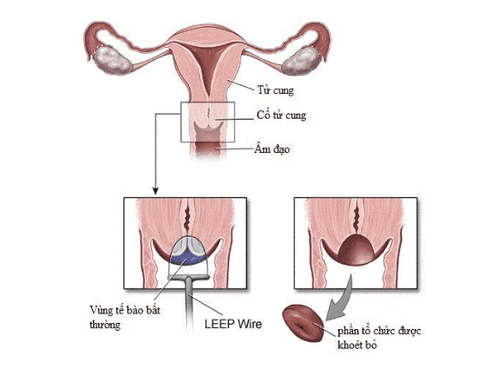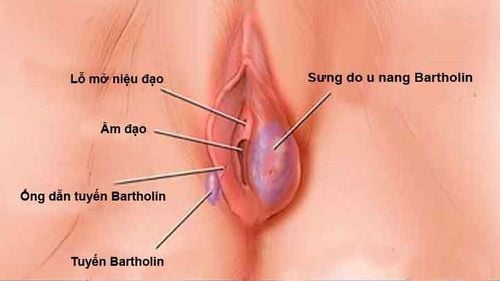This is an automatically translated article.
Cervical cancer is one of the most common cancers of the genital area in women in the developing world and a leading cause of death among women. Cervical cone is a procedure to remove part of the cone of the cervix to remove damaged tissue, to aid in the diagnosis and treatment of early cervical cancer.
1. What is a cervical cone?
There are many methods of treating cervical lesions such as electrocautery, cryotherapy, laser cauterization, electrocautery, laser, electric ring, ... And the technique of cervical cone incision by electric ring ( LEEP - loop electrosurgical excision procedure) is the most commonly used.
Electrocervical cone is the surgical removal of part of the cone of the cervix (the transition zone in the cervix lies within the vagina) to remove the lesion on the cervix and the entire disfigured area. change. This technique can be indicated in diagnosis and treatment with the advantages of being easy to apply, low cost, good hemostasis, obtaining enough intact specimens to send histopathological examination after the procedure. practice tricks.

Khoét chóp cổ tử cung bằng vòng điện là thủ thuật cắt bỏ một phần hình nón của cổ tử cung để loại bỏ tổn thương
2. Indications and contraindications for cervicectomy
What is cervical cone cut for? The aim of the technique is to treat precancerous lesions of the cervix (epithelial dysplasia of mild to severe degrees) and some benign cervical lesions such as: cryotherapy treated but If the desired effect is not achieved, cervical fibroids, cervical polyps,...
2.1 Indications Cervical cone is indicated in the following cases:
There are precancerous or cancerous lesions cervical micro-invasion on cervical curettage specimens; Cervical intraepithelial neoplasia (CIN) recurrence after treatment; Abnormal cytology results, inconsistent with the histopathological diagnosis, and incomplete visualization of the transition zone. 2.2 Contraindications Patients with cardiovascular disease, diabetes, blood pressure have not been stabilized; Patients with blood clotting disorders; People with moderate and severe pelvic inflammatory disease: Delay until treatment is cured; Pregnant women: Delay until the end of the postpartum period.
3. How to perform cervical cone?
3.1 Preparing for a Contour Schedule a Contour within the week after your period to make it easier for your doctor to collect a clean specimen; Patients should inform their doctor about any medications they are taking, and stop taking medicines that can increase the risk of bleeding such as aspirin, naproxen, ibuprofen and warfarin; The patient avoids tampons, enemas, vaginal creams, or sexual activity for at least 24 hours before the biopsy; The patient has colposcopy and biopsies to make histopathology before appointing cervical cone resection; Doctors advise patients on technical procedures, risks and complications; Patients should stop eating at least 8 hours before the procedure. 3.2 Carrying out cervical cone incision The doctor anesthetizes or gives regional anesthesia to the patient, puts the patient in the gynecological position, catheterizes; The doctor places an instrument (speculum) into the vagina to get a better look at the cervix; The doctor removes a sample of the vine cone from the cervix using a hot wire loop (LEEP procedure), scalpel (cold knife biopsy), or laser beam. histopathology. The tissue sample is examined under a microscope for signs of cancer. The cervical cone procedure is usually done in about 1 hour. In addition to the purpose of taking tissue samples for diagnostic purposes, this technique can also be performed to treat the complete removal of diseased tissue from the cervix.
3.3 Post-contouring advice Immediately after surgery, the patient will be taken to the recovery area - where the nurse will take care of and monitor their health. The patient can stay in the recovery area for 1 - 4 hours and can go home. Most women can return to normal activities within 1 week;

Ngay sau khi phẫu thuật, bệnh nhân sẽ được đưa đến khu vực hồi sức - nơi y tá chăm sóc và theo dõi sức khỏe
Patient should not insert anything into the vagina such as tampons or douches for 2 - 6 weeks after the procedure. During this time, the patient should also not engage in sexual activity; Tell your doctor if you have unusual pain in the pelvic area, heavy bleeding (with or without blood clots), severe abdominal pain, or signs of infection (bad-smelling vaginal discharge or fever). ,... If a cone biopsy has been performed, the patient should have regular Pap tests and periodic cervical examination. Pap tests should be done every 4-6 months or as recommended by your doctor. When performing a cervical cone to diagnose and treat cervical diseases, the patient needs to absolutely follow the doctor's instructions to ensure a successful procedure and reduce the risk of complications.
Vinmec International General Hospital performed electrocardiogram (LEEP) cervical cancer screening and treatment. Patients can be completely assured with the advantages of ease of use, low cost, good hemostasis and especially the ability to remove cervical cancer cells very effectively.
Please dial HOTLINE for more information or register for an appointment HERE. Download MyVinmec app to make appointments faster and to manage your bookings easily.













